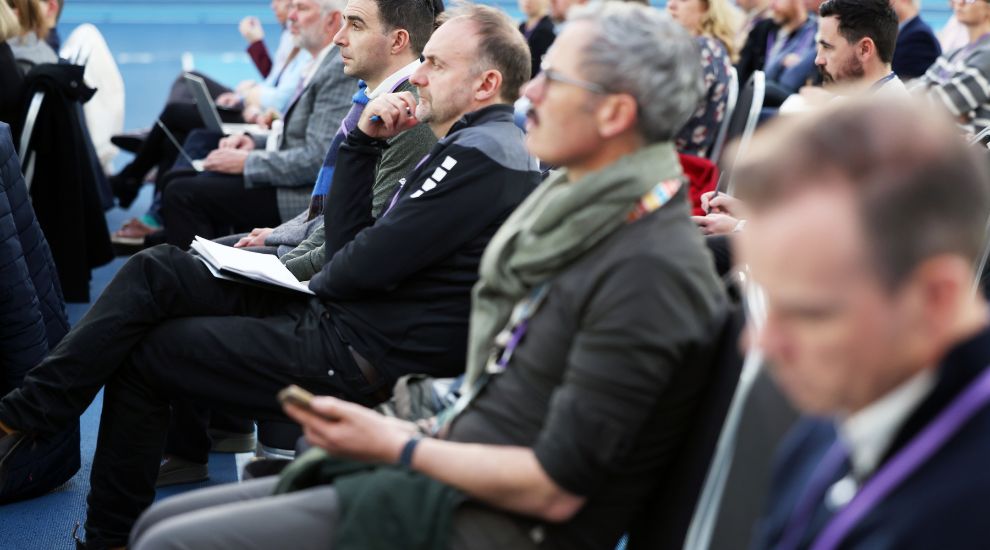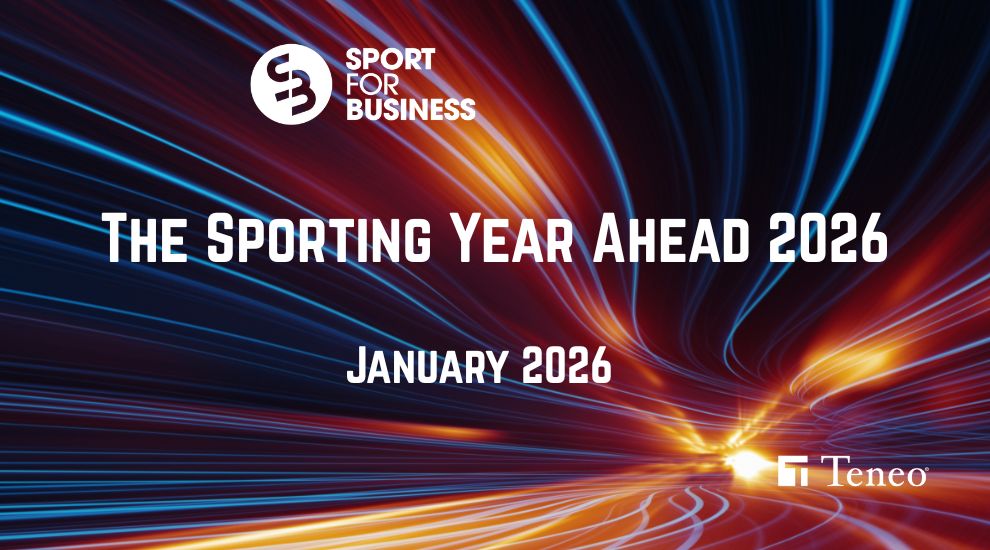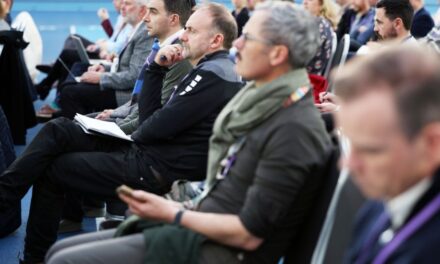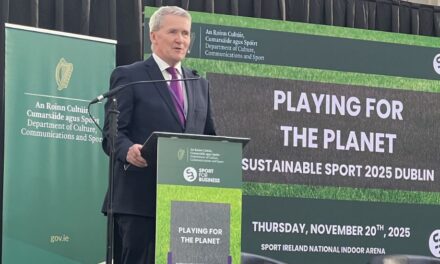Transport has long been recognised as one of the most stubborn components of Ireland’s climate challenge. Yet at last week’s Playing for the Planet conference, it became clear that one of the biggest and least understood contributors sits hidden in plain sight – the weekly movement of millions of people to participate in, support or volunteer in Irish sport.
The issue came to the fore as Rob Hartnett, founder of Sport for Business, welcomed Benny Cullen, Head of Research and Innovation at Sport Ireland, and Robert Cazaciuc, Senior Policy Adviser at the Department of Transport, to explore its scale and to outline what meaningful solutions might look like.
What followed, before an audience drawn from five government departments and a host of sporting bodies, was a compelling case for why sport must be better measured, better planned, and better supported if Ireland is to meet its transport emissions targets.
A National Climate Goal That Sport Cannot Be Absent From
Robert Cazaciuc began with a simple, stark summary of Ireland’s transport challenge. Under the Climate Action Plan, the country must reduce the proportion of all journeys made by car from 72 percent to 53 percent by 2030.
Achieving that requires a combination of modal shift, better infrastructure, and reduced kilometres travelled, because even if cars transition to electric, the system-wide emissions will not fall fast enough without fewer kilometres being driven.
But for all the rigour behind national transport modelling, one area remains almost entirely invisible within it, that of sport.
“Sporting events don’t appear at all in the National Household Travel Survey,” said Cazaciuc. “We think fan and participant travel could be contributing five to ten per cent of Ireland’s transport emissions, but we simply don’t have the data.”
That gap, he noted, is no small oversight. Without understanding the extent of sport-related travel, policymakers cannot target it, clubs cannot plan for it, and climate strategies cannot fully account for the rhythms of Irish life.
The Scale of Sport’s Movement: ‘It’s the Size of the Active Workforce’
To illustrate why the gap matters, Benny Cullen laid out the numbers. Sport is not a niche activity; it is a national habit.
“About 2.1 million adults take part in sport every week,” he said, “and roughly 1.5 million people are members of sports clubs.”
Attendance is equally significant. Around 900,000 people go to sporting events weekly, the majority of them parents supporting their children. Add approximately half a million volunteers and, as Cullen put it, “you’re talking about 2.7 million unique adults every week, and that doesn’t even count the 700,000 to 900,000 children active in sport.”
The comparison he offers is striking: “It’s the size of the active workforce.” And just like the workforce, that scale produces movement. Millions of trips taken every week, often to facilities many kilometres away, at times public transport does not serve.
Sport Ireland’s 2024 Sports Monitor illustrates the imbalance clearly. Across participation, volunteering, match attendance, and parents’ trips to youth sport, car use dominates – between 79 and 95 percent of all trips.
Parents travelling for children’s sport cover the longest distances, averaging over 100 kilometres per week, often in multiple trips to multiple venues.
Using established DEFRA emissions coefficients, Sport Ireland estimates that the average Irish adult generates roughly half a tonne of CO₂ a year solely through sport-related travel.
For a sector that prides itself on promoting physical activity and wellbeing, the carbon impact is significant.
Distance, Not Choice: Why Behaviour Change Alone Won’t Fix It
One of the most important insights from Cullen’s presentation was that the emissions problem is not caused by individual choices. In most cases, the choice simply does not exist.
“Sport isn’t optional,” he said. “It’s essential for health, community and society. But if your nearest club is 13 kilometres away, walking or cycling there isn’t realistic. And public transport is rarely aligned with training times or match schedules.”
This, he argued, makes reducing distances the most powerful tool in cutting emissions. Proximity determines the feasibility of active travel, reduces costs for families, and saves time—one of the biggest barriers to participation. Volunteers also tend to operate close to home, suggesting that well-located clubs strengthen community involvement while also reducing travel.
Sport Ireland is now working with the Office of the Planning Regulator to address these structural issues. Much of Ireland’s planning guidance for sports facilities dates back to the 1980s, and the principles that shaped earlier development, large facilities built on cheaper land outside towns, are no longer fit for a climate-conscious society.
“We’ve proposed including ‘distance to local sports club’ as a KPI in local development plans,” said Cullen. “If we’re planning 60,000 new homes a year, we need to ensure those communities aren’t being designed around long car journeys.”
Designing Fixtures to Reduce Travel
Beyond infrastructure, Cullen highlighted another promising area: optimising the design of sports leagues and fixtures. Sport Ireland is working with the FAI and Nuremberg University on a pilot using logistics-inspired machine learning to minimise travel distances within competitions.
In Germany, similar approaches have reduced travel by up to 30 percent. “Once the league is designed, the individual doesn’t have to make any decisions,” Cullen said. “The system has already reduced the kilometres being driven.”
The potential for replication across other sports—particularly those with frequent youth or regional fixtures—is significant.
A New National Pilot: Making Coach Travel a Core Part of the Fan Experience
If Cullen provided the data and the diagnosis, Cazaciuc returned with one of the more innovative solutions currently on the table – a national pilot to simplify and scale coach travel to sporting events.
The idea is intentionally simple. When fans buy a ticket to certain games, they receive a prompt that coaches are available.
If enough fans in a particular geographic area show interest, the system matches them with private coach operators, generates optimised routes and pick-up points, and confirms journeys. Crucially, clubs themselves would have no administrative burden beyond communications.
Think of how this might work for Inter County teams travelling in the Winter and the Spring, bringing hundreds of fans from Donegal to Kerry or from Galway to Dublin.
“It’s not about putting climate front and centre,” Cazaciuc stressed. “The key is making coach travel easier, more social and more enjoyable. That’s what will drive uptake.”
Many of us can recall an era when coach travel was a central part of Irish sporting culture—when clubs and communities travelled together, building camaraderie along the way. Hartnett himself noted that his own club once hired an entire DART train to take supporters to Croke Park, simply by asking.
The pilot will begin with events of 500 fans or more, over distances of at least 50 kilometres, and will initially be funded and administered by the Department of Transport. The goal is to establish a functioning model that private operators can carry forward once demand is proven.
Measuring What Matters – and Why Sport Should Not Fear It
One of Hartnett’s closing questions was whether sport should feel uneasy about being included more explicitly in national emissions reporting. Cullen was unequivocal in his response. “If you can’t measure it, you can’t manage it,” he said. “Sport’s direct emissions are small. The real issue is scope-three emissions: the travel people do to get to sport. Sport cannot fix that alone. But if it’s measured properly, sport can be prioritised in planning the same way work or retail is.”
Cazaciuc agreed. Current travel surveys, he noted, are well suited to daily routines but fail to capture irregular but high-impact journeys—such as monthly 300-kilometre round trips for matches or competitions. Those large, infrequent trips represent a meaningful share of the carbon footprint, and their omission skews national understanding of where real reductions can be made.
A Sector Ready to Act
If the emissions challenge is significant, so too is the willingness of both sport and government to address it.
The conference showcased examples from GAA clubs, rugby provinces, outdoor sports groups and national bodies, all outlining their own initiatives and barriers. The coach-travel pilot, planning reform, better data, and fixture optimisation emerged as practical steps with real potential.
As Hartnett concluded, “A strong rope is made of many strands, all woven together. That’s exactly what we’re trying to achieve.” In the case of sport and sustainable travel, the strands – planning, data, infrastructure, innovation and community – are now being arranged to pull in the same direction.
Image Credit: Photocall Ireland
Further Reading for Sport for Business members:
Read our Sport for Business Coverage of Sustainability
SPORT FOR BUSINESS Upcoming Events
December 9th – Our 12th Annual Women in Sport Conference in partnership with Lidl.
January 2026 – The Sporting Year Ahead 2026 in partnership with Teneo – Launching Soon
Sport for Business Podcasts
MEMBERSHIP AND EVENT,
All of those organisations who spoke yesterday are among the many organisations among the leading sporting and business organisations in and around the world of sport, who are part of the 300+ members of the Sport for Business community.
This includes all of the leading sports and sponsors, as well as commercial and state agencies, individuals interested in our world, and an increasing number from beyond these shores taking a keen interest in Ireland.
Find out more about becoming a member today.
Or sign up for our twice-daily bulletins to get a flavour of the material we cover.
Sign up for our News Bulletins here.






























